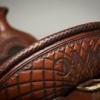Search the Community
Showing results for tags 'molding'.
-
Still very new to leatherwork and enjoying it very much I notice on YouTube some are now forming their leather shapes using food processing vacuum machines to mold the leather around every day objects Just wondered if any on the forum have tried this I imaging you can get some fantastic shapes from household goods One question is once you take it out of the film/bag does it hold its shape whilst it dries
-
I'm going to start a large project. I'm going to create an armor and a shield. I have a detailed tooling design that I really like and have thought a lot about that covers a lot of the leather. To do it well, it's not something that can be done within a 48 hour sitting (long as I can stay awake). Like the chest plate and a large dragon on the sheild. Oval shield. I've been told that you should keep it cased in sections, and that keeping the leather wet for long periods of times is not good for the leather and can create mold. When I cased it in sections for some pieces I had for a 18" dragon head it created waterstains. You can't notice it if you're not looking for it or don't know it's not supposed to be there because I dyed it a darker color and had antique gel. But for this and future projects I want to avoid that. I've also been told that you should mold it after tooling if you do not have a solid mold. Someone else who doesn't have experience said molding after tooling you should use cold water and a hair dryer, and another you should use boiling water. I don't really trust they knew what they were talking about.
- 2 replies
-
- water stains
- casing
-
(and 4 more)
Tagged with:
-
A little fancy for what is essentially a souped-up dirt bike, but with no horse and therefore no need for a saddle - you gotta make do!
-
I'm going to be making a little leather harness with dragon's wings for my bearded dragon. Ideally, I'd like to do a little stamping on the wings to give them texture (like, say, Craftool E294) and then wet shape them over a (yet to be made) form to give them a more 3D effect with the webbing being depressed and "ribs" being elevated. I've never done wet shaping before and the tutorials I've looked up online all show smooth leather being shaped and finished. So, my questions are: 1) Can you do both stamping and wet shaping on the same piece? and 2) If so, in what order should you do them? I feel like I should shape first and then stamp because the stamping might get stretched and misshapen if you did it first. Anyone have any input on this?
-
So I got a problem I´d really like to fix. As I made several sword sheath (Larp) and similar for customers so far (and will do more in the future), I usually wet mold them around a wooden form before stitching, sometimes I add some tooling and sometimes I treat them with hot water to get the a little stiffer. My usually sequence for doing this was more or less this one: - tooling (wet) - molding (wet) - stitching - dyeing - heat treatment/boiling (wet) - applying finish and stuff. So the main problems I got are: 1) When I dye the piece, the colour becomes uneven as some ares are compressed more than others through the process of molding. Maybe it´s usefull to add that I use a sponge for the dye-job, when the colours should be lighter, I wrap some cloth around it so there´ll be less colour per layer) -> My solution would be to dye it before molding, as it´s easier to apply evenly and the fibres are mor even, too. The reason of doing it afterwards was, that the dye stiffens the leather a little bit, but I think an even colour has a higher priority. 2) The main issue is, that the tooling really looses definition. After tooling I case it two more times (molding and "boiling") so it evens out a bit once and again. Besides for the heat treatment I use water hot at about 75 to max. 90 °C (~167 - 194 Fahrenheit) (I use a boiler and a thermometer, so I never get the same temperature). For the process I boil the water and pour it over the stitched sheath on the form, so even if I use 90°C, the leather wouldn´t reach that temperature completeley and won´t get that brittle. But with this molding process, the top grain starts to shrink and every cut from the swivelknife opens up a lot while the stamping starts to fade away... For that problem I got no solution right now and I can´t figure out how to do it right. I think there are some liquids out there used for stiffening leather instead of boiling it, but I don´t know how that will affect the dyejob or the finishing process.... I think it might be an idea to mold the sheath right after tooling to get one casing step out of the line, but then I´d have to case, tool and mold in one step.... Any ideas, tips or solutions to this one?
-
These are my attempts at a leather cell phone case. The stamped one doesn't look too bad but I made the mistake of lining it with pigskin to protect the phone from the metal clip and that made the case a little too small and it is kinda grippy so it is hard to get the phone in and out. Lesson learned the hard way. The second one works fine but also has some issues. The bevelling is uneven, fortunately it doesn't jump out at you in real life as much as it does in the picture.














